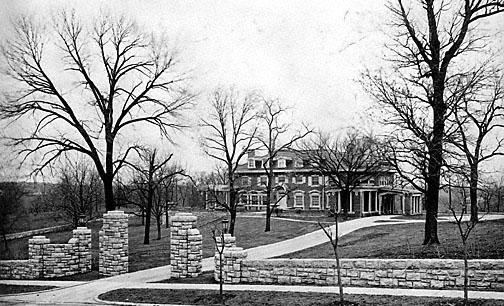 | ||
Dan landis winghaven country club district rep
The Country Club District is the name of a group of neighborhoods comprising a historic upscale residential district in Kansas City, Missouri, and Johnson County, Kansas, USA, developed by noted real estate developer J.C. Nichols. The district was developed in stages between 1906 and 1950, and today is home to approximately 60,000 and includes such well-known Kansas City neighborhoods as Sunset Hill and Brookside in Missouri, Mission Hills, Fairway, and the oldest parts of Prairie Village in Kansas, making it the largest planned community built by a single developer in the United States. Ward Parkway, a wide, manicured boulevard, traverses the district running south from the Country Club Plaza, the first suburban shopping district in the United States.
Contents
- Dan landis winghaven country club district rep
- History
- Controversial restrictive covenants
- School desegregation and white flight
- Homes and residents
- Trivia
- References
History
J.C. Nichols began developing the district in 1906 with a neighborhood he called Bismarck Place. As his development expanded to include Countryside, he began to develop a master plan, which he dubbed the Country Club District because of its proximity to what was then the site of Kansas City Country Club, now Loose Park. Eventually, Nichols acquired a tract of land crossing from Missouri into Kansas, which now includes the neighborhood of Sunset Hill (in Missouri) and the city of Mission Hills (in Kansas). Nichols also built the nearby Country Club Plaza, the first shopping district in the United States designed to accommodate patrons arriving by automobile. Today, the Country Club District is the largest contiguous planned community built by a single developer in the United States.
Controversial restrictive covenants
Nichols used restrictive covenants, or "deed restrictions", in each property in the district to control the use of the land. Most of the covenants pertain to the uses to which the property owner could put his land, or setback and free space requirements.
A controversial aspect of the covenants in the district, however, was the use of racial restrictions that prohibited ownership and occupation by African Americans. The 1948 Supreme Court decision Shelley v. Kraemer rendered such restrictions unenforceable, and the Fair Housing Act of 1968 prohibited the future incorporation of such covenants. Nevertheless, restrictions continue to appear in the deeds to Country Club District properties. The restrictions require that a notice to amend be filed five years in advance of the deed restrictions renewal date, usually every 20 to 25 years; and that all homeowners must agree to the change with a notarized vote. This practical difficulty is the reason racial restrictions continue to appear throughout the district. At the same time, this practical difficulty has protected the other covenants from change, and thus has helped to preserve the essential character of the neighborhood and to resist encroachment by commercial developers.
While he utilized the restrictive covenant model to bar non-whites from his neighborhoods, Nichols was not the first in Kansas City to engage in the practice. In fact, such practice had been in full force in Kansas City since the time Nichols was born in the 1880s. Moreover, although Nichols's covenants were discriminatory, Kansas City historian William S. Worley noted that Nichols was among the first of his contemporaries to abandon the practice of barring sale to Jews.
Today the Country Club District is still predominantly white, and still is home to Kansas City's wealthiest residents.
School desegregation and white flight
On the Missouri side, many Country Club residents formerly sent their children to Southwest High School, a public school in the Kansas City School District. At its peak in the mid-1960s, Southwest enrolled more than 2,400 students, 20% of whose parents were Southwest alumni. After the end of racial segregation in schools under Brown v. Board of Education, however, Kansas City, Missouri, experienced considerable "white flight." It wasn't until the 1970s Southwest High School experienced large scale desegregation. The 1972-1973 school year, Southwest was 2% Black. In the following years, the school saw increases of Black students until becoming predominantely Black in the late 1970s. This was due to full scale busing which began in the 1975-1976 school year. By the 1997-1998 school year, Southwest's final year in existence, enrollment had dropped to below 500. Today, nearly all residents of the Missouri side of the Country Club District send their children to private schools, including Pembroke Hill School, The Barstow School, Rockhurst High School, St. Teresa's Academy, and Notre Dame de Sion.
Homes and residents
The Country Club district includes many homes by or after plans of many noted architects, including Frank Lloyd Wright, McKim, Mead, and White, Louis Curtiss, and Mary Rockwell Hook. Several homes are listed on the National Register of Historic Places. Notable residents of the Country Club District have included:
Trivia
For two weeks in October 1977, renowned artist couple Christo and Jeanne-Claude wrapped Loose Park's 4.5 km of footpaths in 12,500 square meters of shiny, saffron-yellow nylon; the project cost the artists $130,000.
In 1970, members of the Students for a Democratic Society (SDS) were charged with pipe bombing the home of J.C. Nichols, in addition to other places in Kansas City. Three SDS members were convicted. See United States District Court for the Western District of Missouri, Western Division (Kansas City), Criminal Case Files (1879-1972), Case 23498.
